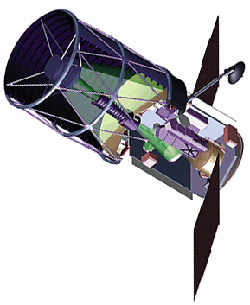A Cosmic Yardstick

Since 1998, cosmologists have become convinced that a mysterious “dark energy” fills the Universe and have come up with many theories describing it. But comparing the current myriad of theories against future observations will be tricky because each model has its own methods for interpreting data. A paper in the 1 October print issue of PRL proposes a new “yardstick” for judging theories using just three, easily measurable quantities. Any theory can be characterized by the relationships it predicts among these three parameters. This direct connection between theory and experiment promises to streamline the analysis of the data that will soon begin pouring in.
Cosmologists believe that dark energy generates an outward pressure that is causing the Universe’s expansion to accelerate. Even more surprising, we seem to live at a point in time when the amounts of matter and dark energy are perfectly balanced. This cosmic equilibrium explains much about the Universe, but our existence at this crucial moment is too coincidental for theorists to accept. Over the past few years, dozens of theories have sprung up to explain dark energy and the apparent “cosmic coincidence.” Observational astronomers are developing experiments to further probe the dark energy, but it’s hard to test so many different types of theories.
A team led by Neal Dalal of the University of California at San Diego has developed a way to check experiments against the forty-odd theories in existence using just three parameters: the average density of dark energy in the Universe today, the average strength with which it pushes against gravity, and a new variable that gauges any interaction between matter and dark energy. Dalal says any theory can be put in terms of these variables, all three of which can be measured with data expected in the next decade. The team simulated sets of data from future experiments and showed that they will be able to eliminate theories using only the three parameters.
The third variable, which measures the interaction between matter and dark energy, also holds the possibility of resolving the cosmic coincidence problem, according to Dalal. Like two children trying to balance a teeter-totter, matter and dark energy might adjust themselves to maintain equilibrium–a process that would require some interaction between the two, even though many of the theories assume there is none. If matter and dark energy do maintain an equilibrium, the two may have been balanced throughout history, which makes the condition of the present day Universe seem less haphazard.
Joshua Frieman, a theoretical astrophysicist at Fermilab in Batavia, Illinois, believes that this work will help rein in some of the more outlandish theories, by reminding theorists that there will soon be measurements to compare with their ideas. For his part, Alex Kim, an observational astronomer at Lawrence Berkeley National Laboratory in California, believes that the new work will eliminate the trying task of testing his future data with various theories.
–Geoff Brumfiel
More Information
One possible explanation for the “cosmic coincidence” involves only fundamental parameters (story from 20 November 2000).


